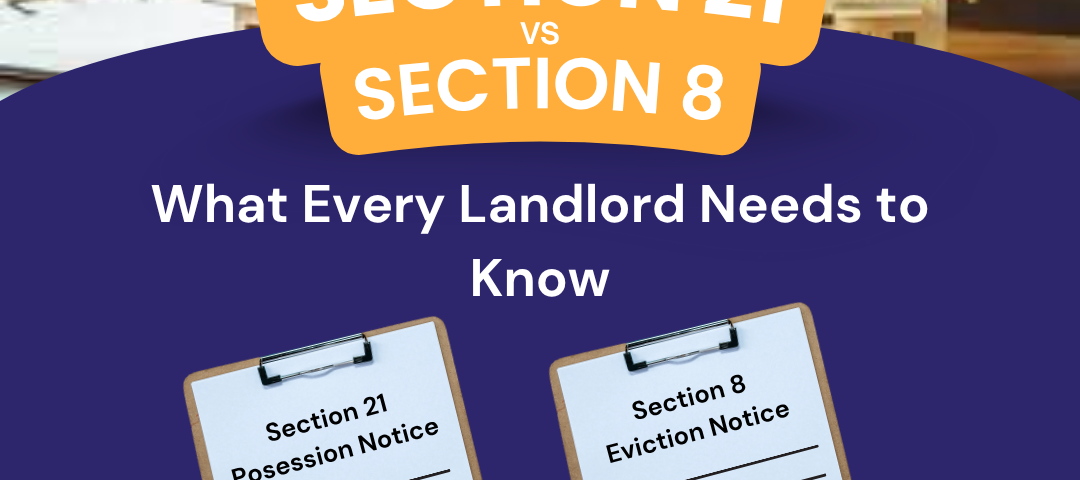
House Prices See Biggest July Drop in the UK
July 29, 2025
Fire Safety in Modern Homes: A Guide for UK Tenants
August 14, 2025As a landlord in England or Wales, knowing how and when to legally regain possession of your rental property is essential. To end a tenancy legally, landlords can use either a Section 21 or Section 8 notice, depending on the situation. Each serves a different purpose and comes with its own set of rules, notice periods, and legal obligations.
In this blog, we’ll explore:
- What Section 21 and Section 8 notices are
- When you should use each one – and when you shouldn’t
- Legal requirements, timelines, and best practices
- The impact of upcoming legislative changes
Let’s break it down so you can make the right decision for your rental situation.
Watch this video to better understand how the Renters Reform Bill could impact Section 21 and Section 8 notices.
What is a Section 21 Notice?
A Section 21 notice allows landlords to legally end an Assured Shorthold Tenancy (AST) without having to show the tenant has done anything wrong—provided all legal requirements are met.
✅ When Should You Use Section 21?
- You’re planning to take back the property either once the fixed-term tenancy ends or while the tenancy is running on a rolling (periodic) basis.
- The tenant has not breached the tenancy agreement.
- You plan to sell the property, move back in, or change tenants.
- You want a quicker, less confrontational process (assuming tenant leaves peacefully).
❌ When Not to Use Section 21:
- The tenancy is still active and there’s no break clause allowing you to end it early.
- You failed to register the tenant’s deposit in one of the approved government-backed protection schemes.
- You didn’t provide key legal documents required at the start of the tenancy—like the EPC, the Gas Safety Record or How to Rent booklet issued by the government.
- You want to evict due to rent arrears or misconduct (use Section 8 instead).
- You’re in an area with selective licensing and don’t have the correct licence.
🕒 Notice Period:
- Landlords are required to provide a minimum of two months’ written notice to end the tenancy (updated for 2025).
Note: Section 21 is only valid if it’s an AST and you’ve complied with all the necessary regulations.
What is a Section 8 Notice?
A Section 8 Notice is sent to a tenant who has broken their lease, such as by not paying rent, damage the property, or acting in a way that is not socially acceptable.
You must specify the ground(s) for eviction, and many of them require you to provide evidence in court.
✅ When Should You Use Section 8?
- The tenant is behind on rent, with arrears reaching at least two months.
- There’s physical damage to the property caused by the tenant.
- The tenant has been involved in anti-social behaviour or illegal activities.
- The tenant has broken terms of the tenancy, such as unauthorised subletting.
❌ When Not to Use Section 8:
- The tenant hasn’t broken any tenancy rules — in that case, use Section 21.
- You want to avoid going to court (Section 8 almost always requires a possession hearing).
- You don’t have solid evidence to prove the grounds for eviction.
- You’re looking for a faster and more guaranteed route (Section 21 may be quicker if valid).
🕒 Notice Period:
- Varies depending on grounds:
- 14 days for rent arrears (Ground 8)
- Immediate notice for serious anti-social behaviour (Ground 14)
- 2 months for some other grounds
Note: You must use Form 3 and submit a court application if the tenant refuses to vacate.
Section 21 vs Section 8 – Key Differences

⚠️ Recent and Upcoming Changes (as of 2025)
The UK government is actively progressing with the Renters Reform Bill, a major proposal that seeks to abolish Section 21 no-fault evictions entirely.
If the bill is approved and becomes law:
- Landlords will have to use Section 8 notices exclusively, which are expected to include broader legal grounds for regaining possession of their properties.
- Tenancy agreements would move to periodic by default.
- Greater emphasis would be placed on evidence-based evictions.
Keep an eye on local authority updates and consult legal experts to stay compliant.
Which Notice Should You Use?

✅ Tips for Serving Valid Notices
- Ensure you’re submitting the appropriate form: Form 6A for Section 21 and Form 3 for Section 8, depending on the type of notice you’re issuing.
- Keep records of delivery (proof of posting, signed receipt, etc.).
- Make sure all legal documents (EPC, gas safety, deposit protection) are up to date.
- If you’re not sure about the grounds or the process, get legal assistance.
🏠 Final Thoughts: Protect Your Investment, Know the Law
Understanding the difference between Section 21 and Section 8 notices is vital for landlords who want to stay compliant, avoid unnecessary legal costs, and manage their tenancies effectively. Whether you’re dealing with rent arrears, anti-social tenants, or simply want your property back, choosing the right notice can make or break your case.

